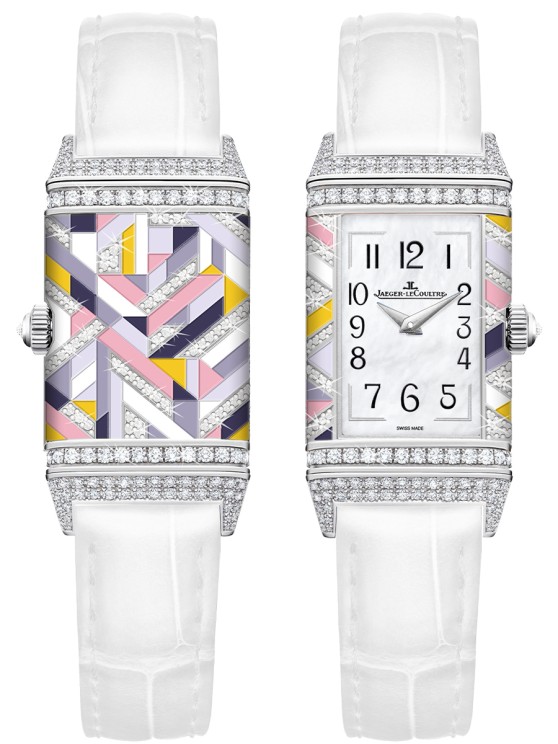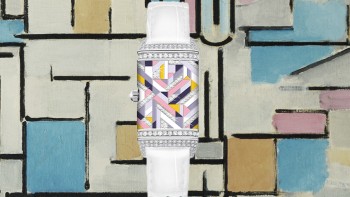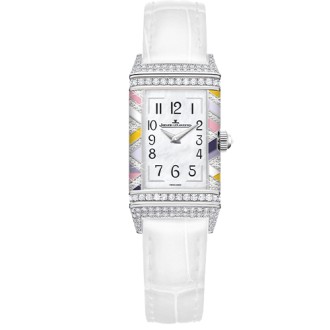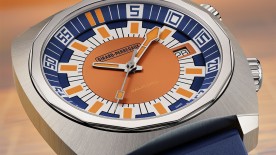Recognised as an icon of Art Deco design, the Reverso has become an exceptional canvas for artistic decoration, exemplified by the feminine Reverso One collection. For 2025, La Grande Maison introduces a new interpretation of the Reverso One ‘Precious Colours’, a masterpiece of enamel and gem-setting first created in 2023. Set in a white gold case (18k, 750/1000), the new timepiece will be produced in a limited edition of 10 pieces.
Inspired by art deco geometry
First introduced in 1931, the Reverso stood out as a quintessential example of Art Deco design. While initially created for the polo field, it quickly began to appear in feminine form, even before the first anniversary of its launch. A practical and elegant merging of aesthetic and function, its blank metal caseback was left free for the wearer to personalise – initially with an engraved message or lacquered motif. From those beginnings, the Maison has explored and developed the creative opportunities presented by the double-sided case, unleashing the art of decoration.
In homage to its origins, the richly decorated case of the Reverso One ‘Precious Colours’ pays direct tribute to Art Deco style. Emerging in the mid-1920s and named (many decades later) after the 1925 Exposition Internationale des Arts Décoratifs in Paris, Art Deco grew directly out of the dramatic social and cultural changes that followed the First World War. With an exuberant and streamlined elegance that emphasised clean, strong lines as an organising principle, it reflected the new sense of freedom and hedonism that permeated every aspect of society. In surface decoration, the repetitive use of parallel lines and rectilinear motifs to form chevrons and zigzags was amplified by blocks of colour and gleaming metal accents, creating a visual dynamism that remains captivating to this day.
Embracing the growing appreciation for rare handcrafts, it is this design language that the talented artisans of Jaeger-LeCoultre’s in-house Métiers RaresTM atelier have translated for the Reverso One ‘Precious Colours’.

A tour-de-force of the decorative crafts
With a scintillating geometric pattern that covers the entire caseback and wraps seamlessly around the case sides to frame the dial, the Reverso One ‘Precious Colours’ unites the crafts of miniature-painted grand feu enamel and diamond-setting. The process of creating this decoration is complex and demanding, requiring full mastery of each technique, as well as the impeccable coordination of the different crafts.
First, the areas destined for gem-setting must be drawn with absolute precision. The remaining areas, which are to be enamelled, are then hollowed out to create a flat surface that must be perfectly uniform, so that there will be no variation in the depth of the enamel and thus the intensity of the colours. To begin the enamelling process, the white gold case metal is sealed with a fondant enamel and fired. Next, to create a pristine surface onto which the multi-coloured design will be painted, the enameller applies two layers of opaque white enamel, with drying and firing after each layer. Then, working entirely by eye, the enameller begins to create the shapes of the geometric design. The raised rectangles that are to be gem-set are used as a reference to determine the choice of angles and dimensions of the triangles and rectangles that are to be enamelled. For this complex pattern, it is essential that no adjoining shapes are exactly the same – and the process is even more challenging where the design continues seamlessly around the case sides to the edge of the dial.
Once the pattern is finalised, the colouring can begin. Using a very fine-tipped sable brush, the entire surface is hand-painted to create the blocks of different colour – again working layer by layer, with firing after every application – until the enameller is fully satisfied with the depth and intensity of each colour. Once the firing of the colours is completed, more layers of transparent fondant are applied. This final coating preserves the colours and enhances the sense of depth; this exceptionally durable surface is then hand-polished to achieve a shiny, glazed appearance, with the smooth finish of a sheet of glass. Known as the Geneva technique – miniature painting protected by layers of transparent enamel – the mastery of this complex process typically requires five years of enamelling experience.
Enamelling the convex case sides of the Reverso One ‘Precious Colours’ at the same time as the flat caseback is particularly challenging, because the two areas require a different consistency of enamel for better adherence during the firing. Equally challenging is the question of colour: just as an artist would do with paints on a palette, the enameller blends different metal oxide pigments together to achieve the desired colour. However, with grand feu enamelling the outcome is unpredictable because firing at 800 degrees Centigrade changes some pigments, causing them not to blend as expected. It is only with years of experience and careful experimentation that an enameller can predict the outcome with any degree of accuracy. The Reverso One ‘Precious Colours’ case requires up to 15 firings, as well as multiple phases of drying at 200 degrees. Excluding the drying time between firings, the enamelling represents 60 hours of work.
After enamelling, the Reverso case is handed over to the gem-setter, who must work with absolute precision to ensure that the diamonds are perfectly set. Using the grain-setting technique, tiny claws of white gold are raised from the flat metal surface to hold each stone in place. This must be done without disturbing the finished enamel nor encroaching on the perfectly straight lines that define the coloured fields and separate them from the gem-set ones. Setting the 277 diamonds (1.59 carats) that decorate the Reverso One ‘Precious Colours’ requires 40 hours of meticulous work.
A great benefit of Jaeger-LeCoultre having its own decorative crafts atelier within the Manufacture, gathering multiple skills together under one roof, is that the different artisans are able to work so closely together, exchanging ideas and sharing their creative energy.
A new interpretation of the Reverso One ‘Precious Colours’
With the dial facing outwards, the Reverso One ‘Precious Colours’ has an elegant presence, the soft glow of white mother-of-pearl complementing the flashes of enamelled colour around its frame and the sparkle of the diamond-set gadroons and lugs. The dial is finely detailed, with the narrow brackets in each corner, the transferred numerals and the Dauphine hands that are signatures of all Reverso One jewellery models. A reverse-set diamond adorns the winding crown, and the watch is fastened to the wrist by a shiny white alligator strap.
Turn the swivelling case over, and the Reverso One ‘Precious Colours’ becomes a piece of High Jewellery, with six different enamel colours complemented by brilliant-cut white diamonds. Three pastel shades in nuances of grey, mauve and pink – colours that epitomise Art Deco style – complement the white gold of the case, and contrasting highlights in dark purple, white and yellow amplify the optical illusion of depth and movement. The use of yellow and pink is especially notable because, of all enamel pigments, they are the least predictable when fired at the high temperatures required for the grand feu process.
Concealed within the case, the movement that powers the Reverso One ‘Precious Colours’ – the hand-wound Calibre 846 – was developed and produced entirely within the Manufacture Jaeger-LeCoultre. It was created specifically for the Reverso and, in keeping with Jaeger-LeCoultre’s philosophy of product integrity, is shaped to follow the contours of the rectangular case.
Reaffirming Jaeger-LeCoultre’s mastery of the decorative crafts along with fine jewellery techniques and deftly fusing functionality, aesthetics and fine watchmaking, this boldly feminine interpretation of the Reverso is a jewel to be worn, as well as a watch to tell the time.






